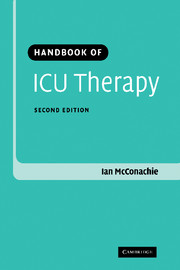Book contents
- Frontmatter
- Contents
- List of contributors
- Preface
- Part I Basic principles
- Part II Specific problems
- 17 The surgical patient in the ICU
- 18 The trauma patient
- 19 Acute coronary syndromes
- 20 Heart failure
- 21 Arrhythmias
- 22 The patient with sepsis
- 23 Acute renal failure in the critically ill
- 24 Acute lung injury and ARDS
- 25 The patient with gastrointestinal problems
- 26 The comatose patient
- 27 The critically ill asthmatic
- 28 The critically ill diabetic
- 29 The cardiac surgical patient in the ICU
- 30 Cardiac arrest
- Index
23 - Acute renal failure in the critically ill
Published online by Cambridge University Press: 24 August 2009
- Frontmatter
- Contents
- List of contributors
- Preface
- Part I Basic principles
- Part II Specific problems
- 17 The surgical patient in the ICU
- 18 The trauma patient
- 19 Acute coronary syndromes
- 20 Heart failure
- 21 Arrhythmias
- 22 The patient with sepsis
- 23 Acute renal failure in the critically ill
- 24 Acute lung injury and ARDS
- 25 The patient with gastrointestinal problems
- 26 The comatose patient
- 27 The critically ill asthmatic
- 28 The critically ill diabetic
- 29 The cardiac surgical patient in the ICU
- 30 Cardiac arrest
- Index
Summary
Introduction
Acute renal failure (ARF) in the critically ill, almost always, develops as part of multiple organ dysfunction (or failure) syndrome.
ARF in the critically ill has high mortality.
Understanding renal physiology and pathophysiology of ARF in the critically ill (especially those with sepsis-associated ARF or SAARF) provides logical guidelines for prevention and/or management of patients at risk.
To date there are no proven pharmacological therapies that “prevent” ARF.
Our understanding of ARF in the critically ill is far from complete.
ARF in the critically ill is distinctly different from “medical” ARF; and management of these patients is often challenging.
Critically ill patients with ARF have higher mortality than a similar cohort of patients without ARF.
Incidence and definition
ARF in the critically ill is not properly defined.
In the literature, definitions for ARF, populations studied and timing of interventions seem to be different in different studies.
This creates problems in interpreting the available literature.
Besides that, defining points at which interventions like renal replacement therapy (RRT) should begin or stop also becomes difficult.
Lack of definition also means that it is difficult to estimate accurate incidence of this disease in our intensive care unit (ICU) patients.
In the literature, the incidence of ARF is quoted as 0.14% (community acquired or “medical” ARF) to 33% in the critically ill. In some recent studies, ARF complicating critical illness has been estimated to be of the order of 4–8%. Based on unpublished data (1997–2001), the incidence of ARF in author's ICU is about 15–20% (a tertiary referral unit).
[…]
- Type
- Chapter
- Information
- Handbook of ICU Therapy , pp. 323 - 333Publisher: Cambridge University PressPrint publication year: 2006

